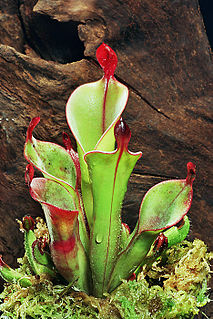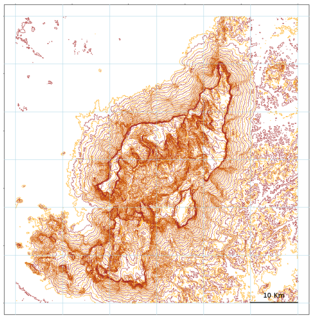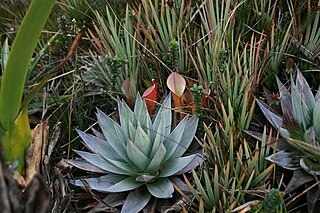
The Guiana Shield is one of the three cratons of the South American Plate. It is a 1.7 billion-year-old Precambrian geological formation in northeast South America that forms a portion of the northern coast. The higher elevations on the shield are called the Guiana Highlands, which is where the table-like mountains called tepuis are found. The Guiana Highlands are also the source of some of the world's most well-known waterfalls such as Angel Falls, Kaieteur Falls and Kuquenan Falls.

A tepui, or tepuy, is a table-top mountain or mesa found in South America, especially in Venezuela and western Guyana. The word tepui means "house of the gods" in the native tongue of the Pemon, the indigenous people who inhabit the Gran Sabana.

The genus Heliamphora contains 23 species of pitcher plants endemic to South America. The species are collectively known as sun pitchers, based on the mistaken notion that the heli of Heliamphora is from the Greek helios, meaning "sun". In fact, the name derives from helos, meaning marsh, so a more accurate translation of their scientific name would be marsh pitcher plants. Species in the genus Heliamphora are carnivorous plants that consist of a modified leaf form that is fused into a tubular shape. They have evolved mechanisms to attract, trap, and kill insects; and control the amount of water in the pitcher. At least one species produces its own proteolytic enzymes that allows it to digest its prey without the help of symbiotic bacteria.

Canaima National Park is a 30,000 km2 (12,000 sq mi) park in south-eastern Venezuela that roughly occupies the same area as the Gran Sabana region. It is located in Bolívar State, reaching the borders with Brazil and Guyana.
La Gran Sabana is a region in southeastern Venezuela, part of the Guianan savanna ecoregion.

Heliamphora chimantensis is a species of marsh pitcher plant endemic to the Chimantá Massif in Venezuela. Specifically, it has been recorded from Apacará and Chimantá Tepuis. It is thought to be more closely related to the southern growing H. tatei and H. neblinae than to any of the other species found in the Gran Sabana and its tepuis. All other species known from this region have between 10 and 15 anthers, while H. tatei, H. neblinae and H. chimantensis have around 20. However, the anthers of H. tatei and the closely related H. neblinae are 7–9 mm long, while those of H. chimantensis only reach 5 mm in length.

Heliamphora heterodoxa is a species of marsh pitcher plant native to Venezuela and adjacent Guyana. It was first discovered in 1944 on the slopes interlinking Ptari-tepui and Sororopan-tepui and formally described in 1951.

Heliamphora hispida is a species of Marsh Pitcher Plant endemic to Cerro Neblina, the southernmost tepui of the Guiana Highlands at the Brazil-Venezuela border.

Heliamphora neblinae is a species of marsh pitcher plant endemic to Cerro de la Neblina, Cerro Aracamuni and Cerro Avispa in Venezuela. It is one of the most variable species in the genus and was once considered to be a variety of H. tatei. It is unclear whether or not there is a consensus regarding its status as a species, with at least a few researchers supporting the taxonomic revision that would elevate both H. tatei var. neblinae and H. tatei f. macdonaldae to full species status.

Heliamphora pulchella is a species of marsh pitcher plant endemic to the Chimanta Massif and surrounding tepuis in Venezuela. It is one of the smallest species and closely related to H. minor.

Heliamphora tatei is a species of marsh pitcher plant endemic to Cerro Duida, Cerro Huachamacari and Cerro Marahuaca in Venezuela. It is closely related to H. macdonaldae, H. neblinae, and H. parva, and all three have in the past been considered forms or varieties of H. tatei. Like H. tatei, these species are noted for their stem-forming growth habit.
Utricularia heterochroma is a very small, possibly perennial, rheophytic carnivorous plant that belongs to the genus Utricularia. U. heterochroma is endemic to Venezuela, where it is known from the type location at Ptari-tepui, two collections from Toronó-tepui, one collection from Apacará-tepui, one collection from Serrania Guanay, and several collections from the Chimantá Massif. It grows as a rheophyte on wet sandstone cliffs near waterfalls among mosses at altitudes from 1,760 m (5,774 ft) to 2,450 m (8,038 ft). It was originally described and published by Julian Alfred Steyermark in 1953.
Heliamphora huberi is a species of Marsh Pitcher Plant endemic to the Chimantá Massif in Venezuela, where it grows at elevations of 1850–2200 m in a variety of habitats. It has thus far been recorded from Angasima-tepui, Apacará-tepui, Amurí-tepui, Acopán-tepui, and the border of Torono- and Chimantá-tepui. Due to its intermediate appearance between species related to H. minor and H. heterodoxa, it is suspected to be of hybridogenic origin.

Cerro de la Neblina, also known as Serra da Neblina in Brazil and Sierra de la Neblina in Venezuela, is a sandstone massif located in the northern Amazon Basin. It is a tilted, heavily eroded plateau, with a deep canyon in its central portion, drained by the Baria River.

The natural range of the carnivorous plant genus Heliamphora is restricted to the southern Venezuelan states of Amazonas and Bolívar, and to adjacent portions of northern Brazil and western Guyana, an area corresponding to the western part of the Guayana Shield. These plants are largely confined to the summits and foothills of the sandstone table-top mountains of the region, known as tepuis.
The Chimantá Massif is a highly fragmented complex of tepuis in Bolívar state, Venezuela. The massif comprises around 11 tepuis and has a total summit area of 615 km2 (237 sq mi) and an estimated slope area of 915 km2 (353 sq mi). It is divided in two by the Río Tírica, with the northern section being both larger and higher. The massif is notable for its high species richness and for its varied habitat types. It reaches an elevation of 2,698 metres (8,852 ft) on its highest peak, Murey-tepui. The massif is situated entirely within the bounds of Canaima National Park. It hosts extensive cave systems, including the world's largest known quartzite cave, Cueva Charles Brewer, named after discoverer Charles Brewer-Carías. The processes behind their speleogenesis are the subject of some debate.
Angasima-tepui, also known as Adanta, Adankasima or Adankachimö, is a tepui in Bolívar state, Venezuela. A relatively isolated peak, both it and nearby Upuigma-tepui lie just south of the vast Chimantá Massif, from which they are separated by the Río Aparurén valley. Amurí-tepui, the closest member of the Chimantá Massif, is only 8 kilometres (5.0 mi) from Angasima-tepui.

Wei-Assipu-tepui, also known as Little Roraima or Roraimita, is a minor tepui of the Eastern Tepuis chain. It lies just off the northeastern flank of Roraima-tepui, directly on the border between Brazil and the disputed Guayana Esequiba territory, claimed by Venezuela but controlled by Guyana, and very close to the tripoint of all three countries. The mountain is known for its extensive cave systems, with one extending for over a kilometre.
Maringma-tepui, also written Mount Maringma and historically known as Mount Marima, is a small tepui of the Pacaraima Mountains in Cuyuni-Mazaruni, Guyana. It is known as Malaima-tepui in the local Akawaio language. Most published sources place it just inside Guyanese territory, very close to the border with Brazil, and around 17 kilometres (11 mi) east of Roraima-tepui. However, the mountain remains the subject of considerable toponymic confusion and its name has been applied to at least one other nearby peak.

Pristimantis jamescameroni is a species of frog belonging to the family Craugastoridae. It is an orange-brown coloured small frog reported so far only from the Aprada-tepui, a table-top mountain in the Bolívar state of Venezuela. It was discovered in June 2012 and formally described in October 2013 by Belgian biologist Philippe J. R. Kok at the Royal Belgian Institute of Natural Sciences and Vrije Universiteit Brussel. The species was named after the Hollywood filmmaker James Cameron, in recognition of his efforts in environmental awareness, and in addition to his public promotion of veganism as a way of animal conservation. Due to its restricted occurrence, the species could be classified as "endangered" according to the criteria of the IUCN Red List of Threatened Species.












